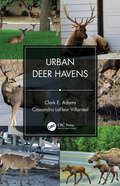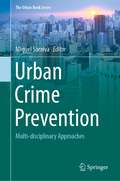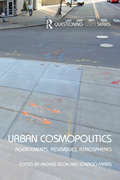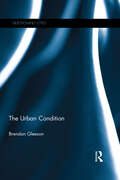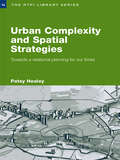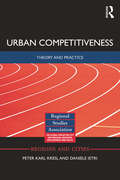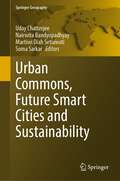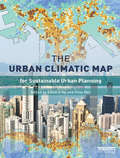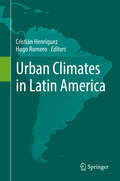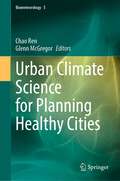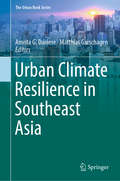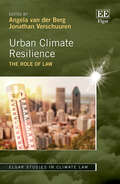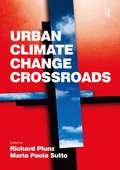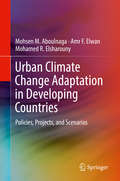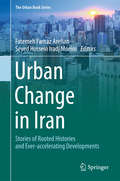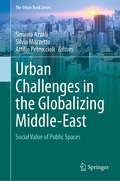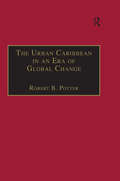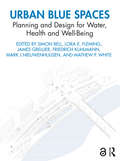- Table View
- List View
Urban Deer Havens
by Clark E. Adams Cassandra LaFleur VillarrealUrban Deer Havens consists of a thorough examination of selected cervid (deer) species that are known to inhabit urban communities in the United States. The deer species that are included in this presentation consisted of white-tailed (Odocoileus virginianus), Key deer (O. v. clavium), moose (Alces alces), elk (Cervus elaphus), mule (Odocoileus hemionus), and black-tailed deer (O. h. columbianus). This book is the first attempt to examine the similarities and differences in those factors that allow the selected cervids to exist and thrive in urban habitats. This information has never been collected, collated, reviewed, and published under one cover document. Yet, all five are known to inhabit urban communities within their geographic range. The lack of information concerning several important examples of urban cervids in conjunction with a proliferation of information on white-tailed deer only is an incomplete and biased presentation. This book is the first comprehensive source of information on urban deer management, which includes a broad assemblage of urban cervids. The overall objective of this book is to provide a more holistic examination of urban cervids. For example, it examines the similarities and differences of the environmental impacts, management strategies, and human dimensions considerations concerning urban cervids in general, and using specific examples. Urban Deer Havens features four chapters that include: Urban deer census techniques and population dynamics Comprehensive tables that review urban community deer management plans National and state-wide estimates the five selected cervids Laws and regulations concerning urban deer Lethal and nonlethal management options for managing deer Steps for managing urban deer populations Examples of urban deer management efforts
Urban Crime Prevention: Multi-disciplinary Approaches (The Urban Book Series)
by Miguel SaraivaThis book provides an original cross-thematic and wide scope review of crime prevention processes in urban areas that are explicitly based on the cooperation between different scientific and professional fields. Focusing primarily on environmental and community-based crime prevention, this book compiles a peer-reviewed collection of papers and prospective essays that explore how, and to what extent, multi-disciplinarity can be used as a cornerstone for achieving safer cities.Relying on the input from specialists, researchers, decision-makers, and practitioners from around the world, it covers the various stages from theory to implementation, by discussing theoretical stances, interpreting policy and planning guidelines, uncovering unique educational experiences, and narrating insights and lessons learned from innovative research and practice. Hence, it provides vivid discussions and invaluable insights into processes of partnership building, planning, and management, oriented towards establishing successful mechanism for preventing crime and reducing feelings of insecurity in urban areas.
Urban Cosmopolitics: Agencements, assemblies, atmospheres (Questioning Cities)
by Anders Blok Ignacio FariasInvoking the notion of ‘cosmopolitics’ from Bruno Latour and Isabelle Stengers, this volume shows how and why cities constitute privileged sites for studying the search for and composition of common worlds of cohabitation. A cosmopolitical approach to the city focuses on the multiple assemblages of human and nonhuman actors that constitute urban common worlds, and on the conflicts and compromises that arise among different ways of assembling the city. It brings into view how urban worlds are always in the process of being subtly transformed, destabilized, decentred, questioned, criticized, or even destroyed. As such, it opens up novel questions as to the gradual and contested composition of urban life, thereby forcing us to pay more explicit attention to the politics of urban assemblages. Focusing on changing sanitation infrastructures and practices, emerging forms of urban activism, processes of economic restructuring, transformations of the built environment, changing politics of expert-based urban planning, as well as novel practices for navigating the urban everyday, the contributions gathered in this volume explore different conceptual and empirical configurations of urban cosmopolitics: agencements, assemblies, atmospheres. Taken together, the volume thus aims at introducing and specifying a novel research program for rethinking urban studies and politics, in ways that remain sensitive to the multiple agencies, materialities, concerns and publics that constitute any urban situation.
Urban Cosmopolitics: Agencements, assemblies, atmospheres (Questioning Cities)
by Anders Blok Ignacio FariasInvoking the notion of ‘cosmopolitics’ from Bruno Latour and Isabelle Stengers, this volume shows how and why cities constitute privileged sites for studying the search for and composition of common worlds of cohabitation. A cosmopolitical approach to the city focuses on the multiple assemblages of human and nonhuman actors that constitute urban common worlds, and on the conflicts and compromises that arise among different ways of assembling the city. It brings into view how urban worlds are always in the process of being subtly transformed, destabilized, decentred, questioned, criticized, or even destroyed. As such, it opens up novel questions as to the gradual and contested composition of urban life, thereby forcing us to pay more explicit attention to the politics of urban assemblages. Focusing on changing sanitation infrastructures and practices, emerging forms of urban activism, processes of economic restructuring, transformations of the built environment, changing politics of expert-based urban planning, as well as novel practices for navigating the urban everyday, the contributions gathered in this volume explore different conceptual and empirical configurations of urban cosmopolitics: agencements, assemblies, atmospheres. Taken together, the volume thus aims at introducing and specifying a novel research program for rethinking urban studies and politics, in ways that remain sensitive to the multiple agencies, materialities, concerns and publics that constitute any urban situation.
The Urban Condition (Questioning Cities)
by Brendan GleesonThis book will speak to the new human epoch, the Urban Age. A majority of humanity now lives for the first time in cities. The city, the highest invention of the modern age, is now the human heartland. And yet the same process that brought us the city and its wonders, modernisation, has also thrown up challenges and threats, especially climate change, resource depletion, social division and economic insecurity. This book considers how these threats are encountered and countered in the urban age, focusing on the issue of human knowledge and self-awareness, just as Hannah Arendt’s influential The Human Condition did half a century ago. The Human Condition is now The Urban Condition. And it is this condition that will define human prospects in an age of default and risk. Gleeson expertly explores the concept through three main themes. The first is an exploration of what defines the current human condition, especially the expanding cities that are at the heart of an over-consumptive world economic order. The second exposes and reviews the reawakening of forms of knowledge (‘naturalism’) that are likely to worsen not improve our comprehension of the crisis. The new ‘science of urbanism’ in popular new literature exemplifies this dangerous trend. The third and last part of the book considers prospects for a new urban, and therefore human, dispensation, ‘The Good City’. We must first journey in our urban vessels through troubled times. But can we now start to plot the way to new shores, to a safer, more resilient city that provides for human flourishing? The Urban Condition attempts this ideal, conceiving a new urbanism based on the old idea of self-limitation. The Urban Condition is an original, timely book that reconsiders and redeploys Arendt’s famous notion of The Human Condition in an age of cities and risk. It brings together several important strands of human consideration, urbanisation, climate threat, resource depletion, economic default and critical knowledge and weaves them into a new analysis of the times. It also looks to a future that is nearly with us—of changed climate, resource scarcity and economic stress. The book journeys into these troubled times, proposing the idea of Lifeboat Cities as a way of thinking about the human journey to come
The Urban Condition (Questioning Cities)
by Brendan GleesonThis book will speak to the new human epoch, the Urban Age. A majority of humanity now lives for the first time in cities. The city, the highest invention of the modern age, is now the human heartland. And yet the same process that brought us the city and its wonders, modernisation, has also thrown up challenges and threats, especially climate change, resource depletion, social division and economic insecurity. This book considers how these threats are encountered and countered in the urban age, focusing on the issue of human knowledge and self-awareness, just as Hannah Arendt’s influential The Human Condition did half a century ago. The Human Condition is now The Urban Condition. And it is this condition that will define human prospects in an age of default and risk. Gleeson expertly explores the concept through three main themes. The first is an exploration of what defines the current human condition, especially the expanding cities that are at the heart of an over-consumptive world economic order. The second exposes and reviews the reawakening of forms of knowledge (‘naturalism’) that are likely to worsen not improve our comprehension of the crisis. The new ‘science of urbanism’ in popular new literature exemplifies this dangerous trend. The third and last part of the book considers prospects for a new urban, and therefore human, dispensation, ‘The Good City’. We must first journey in our urban vessels through troubled times. But can we now start to plot the way to new shores, to a safer, more resilient city that provides for human flourishing? The Urban Condition attempts this ideal, conceiving a new urbanism based on the old idea of self-limitation. The Urban Condition is an original, timely book that reconsiders and redeploys Arendt’s famous notion of The Human Condition in an age of cities and risk. It brings together several important strands of human consideration, urbanisation, climate threat, resource depletion, economic default and critical knowledge and weaves them into a new analysis of the times. It also looks to a future that is nearly with us—of changed climate, resource scarcity and economic stress. The book journeys into these troubled times, proposing the idea of Lifeboat Cities as a way of thinking about the human journey to come
Urban Complexity and Spatial Strategies: Towards a Relational Planning for Our Times (RTPI Library Series)
by Patsy HealeyUrban Complexity and Spatial Strategies develops important new relational and institutionalist approaches to policy analysis and planning, of relevance to all those with an interest in cities and urban areas. Well-illustrated chapters weave together conceptual development, experience and implications for future practice and address the challenge of urban and metropolitan planning and development. Useful for students, social scientists and policy makers, Urban Complexity and Spatial Strategies offers concepts and detailed cases of interest to those involved in policy development and management, as well as providing a foundation of ideas and experiences, an account of the place-focused practices of governance and an approach to the analysis of governance dynamics. For those in the planning field itself, this book re-interprets the role of planning frameworks in linking spatial patterns to social dynamics with twenty-first century relevance.
Urban Complexity and Spatial Strategies: Towards a Relational Planning for Our Times (RTPI Library Series)
by Patsy HealeyUrban Complexity and Spatial Strategies develops important new relational and institutionalist approaches to policy analysis and planning, of relevance to all those with an interest in cities and urban areas. Well-illustrated chapters weave together conceptual development, experience and implications for future practice and address the challenge of urban and metropolitan planning and development. Useful for students, social scientists and policy makers, Urban Complexity and Spatial Strategies offers concepts and detailed cases of interest to those involved in policy development and management, as well as providing a foundation of ideas and experiences, an account of the place-focused practices of governance and an approach to the analysis of governance dynamics. For those in the planning field itself, this book re-interprets the role of planning frameworks in linking spatial patterns to social dynamics with twenty-first century relevance.
Urban Competitiveness: Theory and Practice (Regions and Cities)
by Peter Kresl Daniele IetriDuring the past 25 years the burden of managing economic policy for competitiveness has devolved to cities and to urban regions. National governments have increasingly been focused on staving off fiscal collapse. Mayors and local administrations have become very creative and active in looking after the state of their local economy and have developed extensive agencies for inter-city cooperation and action. This book explores this evolving role of cities and urban regions. Intelligent and rational policy must be based on an accurate understanding of the situation at hand and of the economic theory that can be utilized in the assessment of the most effective means that can be deployed. This book examines the theoretical contributions of economists and geographers and through the analyses of the performance of various cities will give the reader an understanding of the logic behind rational policy formation. Evaluation of a city’s relative competitiveness is a controversial matter and this book provides a full treatment of the various approaches. Finally, it examines the experiences with competitiveness of several cities in North America and in Europe. Urban Competitiveness: Theory and Practice confirms that many cities in trying times do have a mechanism for enhancing their competitiveness and can work to create the sort of economic life the city’s residents want.
Urban Competitiveness: Theory and Practice (Regions and Cities)
by Peter Kresl Daniele IetriDuring the past 25 years the burden of managing economic policy for competitiveness has devolved to cities and to urban regions. National governments have increasingly been focused on staving off fiscal collapse. Mayors and local administrations have become very creative and active in looking after the state of their local economy and have developed extensive agencies for inter-city cooperation and action. This book explores this evolving role of cities and urban regions. Intelligent and rational policy must be based on an accurate understanding of the situation at hand and of the economic theory that can be utilized in the assessment of the most effective means that can be deployed. This book examines the theoretical contributions of economists and geographers and through the analyses of the performance of various cities will give the reader an understanding of the logic behind rational policy formation. Evaluation of a city’s relative competitiveness is a controversial matter and this book provides a full treatment of the various approaches. Finally, it examines the experiences with competitiveness of several cities in North America and in Europe. Urban Competitiveness: Theory and Practice confirms that many cities in trying times do have a mechanism for enhancing their competitiveness and can work to create the sort of economic life the city’s residents want.
Urban Commons, Future Smart Cities and Sustainability (Springer Geography)
by Uday Chatterjee Nairwita Bandyopadhyay Martiwi Diah Setiawati Soma SarkarThis book provides a critical theoretical framework for understanding the implementation and development of smart cities as innovation drivers, with long-term effects on productivity, livability, and the sustainability of specific initiatives. This framework is based on an empirical analysis of 21 case studies, which include pioneer projects from various regions. It investigates how successful smart city initiatives foster technological innovation by combining regulatory governance and private agency. The typologies of smart city-making approaches are thoroughly examined. This book presents the holistic approach of smart cities, which start from current issue and challenges, advanced technological development, disaster mitigation, ecological perspective, social issue, and urban governance. The book is organized into five major parts, which reflect interconnection between theories and practice. Part one explains the introduction which reflects the diversity and challenges of the urban commons and its regeneration. Part two covers the current and future situation of urban growth, anglomeration agglomeration, and urban infrastructure. This section includes rethinking urban sprawl: moving towards sustainable cities, drivers of urban growth and infrastructure, urban land use dynamics and urban sprawl and urban infrastructure sustainability and resilience. Part three describes climate crisis, urban health, and waste management. This section includes climate change and health impacts in urban areas, green spaces: an invaluable resource for delivering sustainable urban health, health and wellbeing and quality of life in the changing urban environment, urban climate and pollution—case study, sustainable urban waste management and urban sustainability and global warming and urban heat Island. Part four covers the ecological perspectives, advanced technology, and social impact for i.e., smart building, ecosystem services, society and future smart cities (SSC). This section includes urban ecosystem services, environmental planning, and city management, artificial intelligence and urban hazards and societal impact, and using geospatial application and urban/smart city energy conservation—case study. Part five covers urban governance, smart solutions, and sustainable cities. It includes good governance, especially e-governance and citizen participation, urban governance, space and policy planning to achieve sustainability, smart city planning and management and Internet of things (IoT), advances in smart roads for future smart cities, sustainable city planning, innovation, and management, future strategy for sustainable smart cities and lessons from the pandemic: the future of smart cities.
The Urban Climatic Map: A Methodology for Sustainable Urban Planning
by Edward Ng Chao RenRapid urbanization, higher density and more compact cities have brought about a new science of urban climatology. An understanding of the mapping of this phenomenon is crucial for urban planners. The book brings together experts in the field of Urban Climatic Mapping to provide the state of the art understanding on how urban climatic knowledge can be made available and utilized by urban planners. The book contains the technology, methodology, and various focuses and approaches of urban climatic map making. It illustrates this understanding with examples and case studies from around the world, and it explains how urban climatic information can be analysed, interpreted and applied in urban planning. The book attempts to bridge the gap between the science of urban climatology and the practice of urban planning. It provides a useful one-stop reference for postgraduates, academics and urban climatologists wishing to better understand the needs for urban climatic knowledge in city planning; and urban planners and policy makers interested in applying the knowledge to design future sustainable cities and quality urban spaces.
The Urban Climatic Map: A Methodology for Sustainable Urban Planning
by Edward Ng Chao RenRapid urbanization, higher density and more compact cities have brought about a new science of urban climatology. An understanding of the mapping of this phenomenon is crucial for urban planners. The book brings together experts in the field of Urban Climatic Mapping to provide the state of the art understanding on how urban climatic knowledge can be made available and utilized by urban planners. The book contains the technology, methodology, and various focuses and approaches of urban climatic map making. It illustrates this understanding with examples and case studies from around the world, and it explains how urban climatic information can be analysed, interpreted and applied in urban planning. The book attempts to bridge the gap between the science of urban climatology and the practice of urban planning. It provides a useful one-stop reference for postgraduates, academics and urban climatologists wishing to better understand the needs for urban climatic knowledge in city planning; and urban planners and policy makers interested in applying the knowledge to design future sustainable cities and quality urban spaces.
Urban Climates in Latin America
by Cristián Henríquez Hugo RomeroThis book describes the observation of urban climates in Latin-American and their relationships with urban sprawl, the economic emergence of Latin American countries, social segregation, urban ecology, disasters and resilience. The chapters include contributions dealing with urban heat islands, local climate zones, thermal comfort, air pollution, extreme climate index, green infrastructure, health issues and adaptions based on the socio-economic background of urban areas. This book revises the role of urban planning and environmental governance, highlighting the singularities in climate adaptation policies in developing countries.
Urban Climate Science for Planning Healthy Cities (Biometeorology #5)
by Chao Ren Glenn McGregorThis volume demonstrates how urban climate science can provide valuable information for planning healthy cities. The book illustrates the idea of "Science in Time, Science in Place" by providing worldwide case-based urban climatic planning applications for a variety of regions and countries, utilizing relevant climatic-spatial planning experiences to address local climatic and environmental health issues. Comprised of three major sections entitled "The Rise of Mega-cities and the Concept of Climate Resilience and Healthy Living," "Urban Climate Science in Action," and "Future Challenges and the Way Forward," the book argues for the recognition of climate as a key element of healthy cities. Topics covered include: urban resilience in a climate context, climate responsive planning and urban climate interventions to achieve healthy cities, climate extremes, public health impact, urban climate-related health risk information, urban design and planning, and governance and management of sustainable urban development. The book will appeal to an international audience of practicing planners and designers, public health and built environment professionals, social scientists, researchers in epidemiology, climatology and biometeorology, and international to city scale policy makers.
Urban Climate Resilience in Southeast Asia (The Urban Book Series)
by Amrita G. Daniere Matthias GarschagenThis volume explores how climate change impacts interact with poverty and vulnerability to increase the risk for urban residents in Southeast Asia. It combines knowledge from both academic literature and action research to explore the creation of climate resilient urban governance that is both inclusive and equitable. The book contains contributions from researchers in different cities in Southeast Asia involved with the major research project Building Urban Climate Change Resilience in Southeast Asian Cities (UCRSEA). The authors respond to three urgent questions: How does climate change interact with poverty and vulnerability to create risk for urban residents in Southeast Asia?What does knowledge, from both academic literature and action research, tell us about creating climate resilient urban governance that is both inclusive and equitable?How can we strengthen the agency of individuals, groups and institutions to improve economic, physical and social well-being in urban areas, particularly in response to climate change? The book hopes to answer to current challenges posed by climate change. In the volume, the authors discuss how the agency of individuals, groups and institutions can be strengthened to improve economic, physical and social well-being in urban areas, particularly in response to climate change.
Urban Climate Resilience: The Role of Law (Elgar Studies in Climate Law)
This significant book addresses the most important legal issues that cities face when attempting to adapt to the changing climate. This includes how to become more resilient against the impacts of climate change such as sea level rise, increases in the intensity and frequency of storms, floods, droughts, and extreme temperatures.A range of expert contributors are brought together to assess the current state of climate change law and policy at the city level, featuring analysis of key legal instruments that can help urban societies adapt to, and cope with, the changing climate. Chapters contain comparative assessments of urban climate change policies in cities across the world, in both developed and developing countries, including Ghana, South Africa, Indonesia, the Netherlands and the US. Additionally, the book analyses legal approaches, relying on planning law and other legal instruments in the hands of city governments, which can aid in combating specific problems such as the urban heat island effect.Providing an up-to-date analysis of climate change adaptation and mitigation law at the level of cities, Urban Climate Resilience will be a key resource for academics and students of environmental law, public international law, urban planning and sustainability. The lessons for future policies and laws to create more climate resilient cities will also be useful for local policymakers, regulators and city government officials working on climate change at the local level.
Urban Climate Change Crossroads
by Maria Paola SuttoUrban climate change is a crossroads in two very different senses. One is historical. With the world now more than half urban, and given the ecological consequences of the world's high-consumption urban centers, we are at an ecological crossroad. We either head off the worst of ecological collapse through concerted and forward-looking action, or we face a 'Mad Max future' of dystopia, violence, and upheaval. The second crossroad is intellectual. Our individual disciplines are unable to grasp the magnitude of the economic-ecological challenges ahead. For that we need to work holistically, calling on the knowledge of climatologists, engineers, sociologists, economists, public health specialist, designers, architects, community organizers, and more. The intellectual crossroad is nothing less than a new intellectual field of Sustainable Development. Based on a major international forum held in Rome in 2008, this volume brings together leading climate change experts to engage with the climate change discourse as it shifts from mitigation to adaptation, with particular attention to the urban environment. In doing so, it provides important insights into how to deal with the first crossroad, by achieving the second. It represents a new generation of thinking involving not only science, but the broad array of fields that must be called upon to effectively address the global climate crisis: from ecological science to political science; from economics to philosophy to architecture; and from public health to public art. It is a pioneering effort to broaden the discursive field, and is likely to remain a landmark study on the subject for a generation.
Urban Climate Change Crossroads
by Maria Paola SuttoUrban climate change is a crossroads in two very different senses. One is historical. With the world now more than half urban, and given the ecological consequences of the world's high-consumption urban centers, we are at an ecological crossroad. We either head off the worst of ecological collapse through concerted and forward-looking action, or we face a 'Mad Max future' of dystopia, violence, and upheaval. The second crossroad is intellectual. Our individual disciplines are unable to grasp the magnitude of the economic-ecological challenges ahead. For that we need to work holistically, calling on the knowledge of climatologists, engineers, sociologists, economists, public health specialist, designers, architects, community organizers, and more. The intellectual crossroad is nothing less than a new intellectual field of Sustainable Development. Based on a major international forum held in Rome in 2008, this volume brings together leading climate change experts to engage with the climate change discourse as it shifts from mitigation to adaptation, with particular attention to the urban environment. In doing so, it provides important insights into how to deal with the first crossroad, by achieving the second. It represents a new generation of thinking involving not only science, but the broad array of fields that must be called upon to effectively address the global climate crisis: from ecological science to political science; from economics to philosophy to architecture; and from public health to public art. It is a pioneering effort to broaden the discursive field, and is likely to remain a landmark study on the subject for a generation.
Urban Climate Change Adaptation in Developing Countries: Policies, Projects, and Scenarios
by Mohsen M. Aboulnaga Amr F. Elwan Mohamed R. ElsharounyThis book describes the risks, impacts, measures, actions and adaptation policies that have developed globally as a result of the severe impacts of global climate change. In-depth chapters focus on climate change assessment (CCA) in terms of vulnerabilities and reflection on the built environment and measures and actions for infrastructure and urban areas. Adaptation actions specific to developing countries such as Egypt are presented and illustrated. Global Climate change adaptation projects (CCAPs) in developing countries, in terms of their targets and performance, are presented and compared with those existing CCAPs in Egypt to draw learned lessons. Climate change scenarios 2080 using simulations are portrayed and discussed with emphasis on a case-study model from existing social housing projects in hot-arid urban areas in Cairo; in an effort to put forward an assessment and evaluation of current CCA techniques. This book helps researchers realize the global impacts of climate change on the built environment and economic sectors, and enhances their understanding of current climate change measures, actions, policies, projects and scenarios.Reviews and illustrates the impact of global climate change risks;Provides an understanding of global climate change risks in seven continents;Illustrates policies and action plans implemented at the global level and developing countries' level;Discusses climate change assessment and vulnerabilities with emphasis on urban areas;Presents measures and action plans to mitigate climate change scenarios by 2080.
Urban Change in Iran: Stories of Rooted Histories and Ever-accelerating Developments (The Urban Book Series)
by Fatemeh Farnaz Arefian Seyed Hossein Iradj MoeiniThis book, based on conference excerpts, investigates various aspects of contemporary Iranian urbanism. The topics covered range from the impacts of political developments on the cities’ rapid socio-economic developments, to the cities’ troubled relationship with the country’s built-environment history and their frequently ill-managed exposure to Western notions of development and globalisation. Last but not least, the country’s vulnerability to natural disasters in an age of increasing urban-population densification is also considered. Alongside more theoretically and artistically oriented debates, the book’s individual contributions turn their attention to the now much higher proportion of urban dwellers in the country’s rising population. It also discusses the policies designed in response to these demographic moves, including those to develop new towns, find housing for the excess population in existing cities, renovate historic buildings and create new public spaces. The practice-policy oriented contributions also include those concerning the country’s responses to natural disasters.
Urban Challenges in the Globalizing Middle-East: Social Value of Public Spaces (The Urban Book Series)
by Simona Azzali Silvia Mazzetto Attilio PetruccioliThis publication aims to investigate the nature of social life in public and urban spaces in the cities of the Middle East, considering the value of environmental approaches. It aims to develop a better understanding of the patterns of social interactions and activities in public places, which have been influenced by cultural heritage values.Sustainable and livable open spaces can help in improving living conditions in cities. Public spaces are relevant as they satisfy many human needs. In public spaces, people interact and meet; people with different cultures and social backgrounds can communicate and learn from each other in social and spontaneous ways. However, decision-makers tend to forget the value of public spaces, especially in the absence of a national regulatory framework in emerging globalized cities.The book provides a multi-disciplinary approach in reading the characteristics and values of public spaces in the emerging cities of the Middle East.
The Urban Caribbean in an Era of Global Change
by Robert B. PotterBased on the author’s first hand field research, this book addresses the twin processes of urbanization and globalization as they affect the contemporary Caribbean region. One of the key aims of the book is to focus attention on the fact that contrary to popular perceptions, the Caribbean is highly urbanized. Indeed statistics show that the region is more highly urbanized than the world taken as a whole. In addition, the fact that the Caribbean region has always been affected by processes of globalization, in respect of its economy, polity and society, is central to the text. The chapters cover pressing topics such as urban change and the evolution of mini-metropolitan regions, the importance of the mercantile and plantopolis frameworks, tourism, post modernity and the urban nexus, economic change and the dual processes of global convergence and divergence, and the nature of the relationships existing between the state, the informal sector, housing and environmental conditions. In reality, it is shown that the development of tourism and enclave manufacturing is leading to new forms of urban concentration, and not spatial dispersal.
The Urban Caribbean in an Era of Global Change
by Robert B. PotterBased on the author’s first hand field research, this book addresses the twin processes of urbanization and globalization as they affect the contemporary Caribbean region. One of the key aims of the book is to focus attention on the fact that contrary to popular perceptions, the Caribbean is highly urbanized. Indeed statistics show that the region is more highly urbanized than the world taken as a whole. In addition, the fact that the Caribbean region has always been affected by processes of globalization, in respect of its economy, polity and society, is central to the text. The chapters cover pressing topics such as urban change and the evolution of mini-metropolitan regions, the importance of the mercantile and plantopolis frameworks, tourism, post modernity and the urban nexus, economic change and the dual processes of global convergence and divergence, and the nature of the relationships existing between the state, the informal sector, housing and environmental conditions. In reality, it is shown that the development of tourism and enclave manufacturing is leading to new forms of urban concentration, and not spatial dispersal.
Urban Blue Spaces: Planning and Design for Water, Health and Well-Being
by Simon Bell Lora E. Fleming James Grellier Friedrich Kuhlmann Mark J. Nieuwenhuijsen Mathew P. WhiteThis book presents an evidence-based approach to landscape planning and design for urban blue spaces that maximises the benefits to human health and well-being while minimising the risks. Based on applied research and evidence from primary and secondary data sources stemming from the EU-funded BlueHealth project, the book presents nature-based solutions to promote sustainable and resilient cities. Numerous cities around the world are located alongside bodies of water in the form of coastlines, lakes, rivers and canals, but the relationship between city inhabitants and these water sources has often been ambivalent. In many cities, water has been polluted, engineered or ignored completely. But, due to an increasing awareness of the strong connections between city, people, nature and water and health, this paradigm is shifting. The international editorial team, consisting of researchers and professionals across several disciplines, leads the reader through theoretical aspects, evidence, illustrated case studies, risk assessment and a series of validated tools to aid planning and design before finishing with overarching planning and design principles for a range of blue-space types. Over 200 full-colour illustrations accompany the case-study examples from geographic locations all over the world, including Portugal, the United Kingdom, China, Canada, the US, South Korea, Singapore, Norway and Estonia. With green and blue infrastructure now at the forefront of current policies and trends to promote healthy, sustainable cities, Urban Blue Spaces is a must-have for professionals and students in landscape planning, urban design and environmental design. Open Access for the book was funded by the European Union's Horizon 2020 research and innovation programme under grant agreement No 666773
